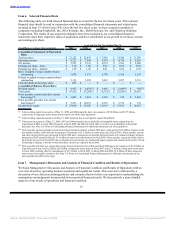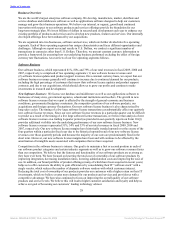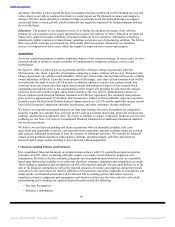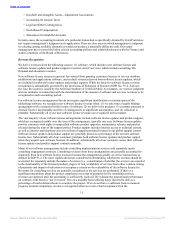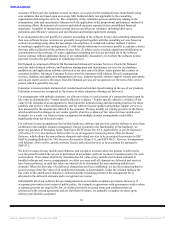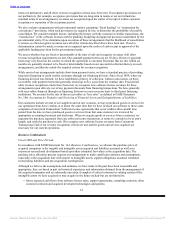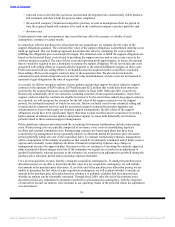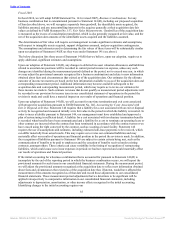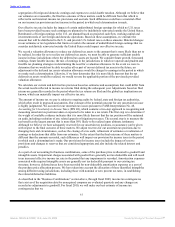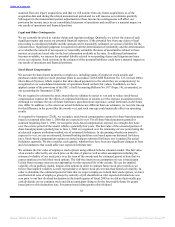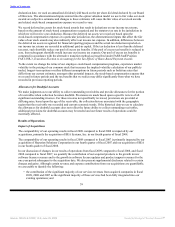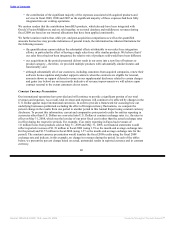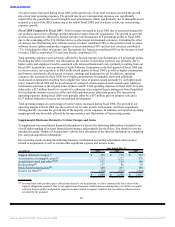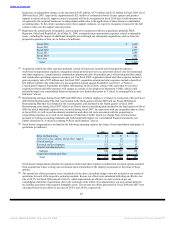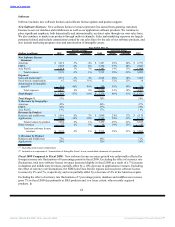Oracle 2008 Annual Report Download - page 41
Download and view the complete annual report
Please find page 41 of the 2008 Oracle annual report below. You can navigate through the pages in the report by either clicking on the pages listed below, or by using the keyword search tool below to find specific information within the annual report.
Table of Contents
management to apply judgment in determining whether the subsequent information received relates to facts
and circumstances that existed for the provisional items as of the acquisition date, including information that
affects the estimated amounts involved. To the extent significant measurement period adjustments are
identified, the comparative financial information we present for a reporting period could be materially revised
in comparison to that which we had previously presented in our earnings releases and related filings with the
U.S. Securities and Exchange Commission (SEC).
Our adoption of Statement 141(R) in fiscal 2010 will also change how we account for certain other areas of
business combinations in comparison to how these areas are currently accounted for pursuant to Statement
141 and related accounting guidance, including the expensing of direct transaction costs.
Goodwill and Intangible Assets—Impairment Assessments
We review goodwill for impairment annually and whenever events or changes in circumstances indicate its
carrying value may not be recoverable in accordance with FASB Statement No. 142, Goodwill and Other
Intangible Assets. The provisions of Statement 142 require that a two-step impairment test be performed on
goodwill. In the first step, we compare the fair value of each reporting unit to its carrying value. Our reporting
units are consistent with the reportable segments identified in Note 15 of Notes to Consolidated Financial
Statements. If the fair value of the reporting unit exceeds the carrying value of the net assets assigned to that
unit, goodwill is not considered impaired and we are not required to perform further testing. If the carrying
value of the net assets assigned to the reporting unit exceeds the fair value of the reporting unit, then we must
perform the second step of the impairment test in order to determine the implied fair value of the reporting
unit’s goodwill. If the carrying value of a reporting unit’s goodwill exceeds its implied fair value, then we
would record an impairment loss equal to the difference.
Determining the fair value of a reporting unit involves the use of significant estimates and assumptions. These
estimates and assumptions include revenue growth rates and operating margins used to calculate projected
future cash flows, risk-adjusted discount rates, future economic and market conditions and determination of
appropriate market comparables. We base our fair value estimates on assumptions we believe to be reasonable
but that are unpredictable and inherently uncertain. Actual future results may differ from those estimates. In
addition, we make certain judgments and assumptions in allocating shared assets and liabilities to determine
the carrying values for each of our reporting units. Our most recent annual goodwill impairment analysis,
which was performed during the fourth quarter of fiscal 2009, did not result in an impairment charge, nor did
we record any goodwill impairment in fiscal 2008 or 2007.
We make judgments about the recoverability of purchased intangible assets whenever events or changes in
circumstances indicate that an other than temporary impairment may exist. Each period we evaluate the
estimated remaining useful lives of purchased intangible assets and whether events or changes in
circumstances warrant a revision to the remaining periods of amortization. In accordance with FASB
Statement No. 144, Accounting for the Impairment or Disposal of Long-Lived Assets, recoverability of these
assets is measured by comparison of the carrying amount of the asset to the future undiscounted cash flows
the asset is expected to generate. If the asset is considered to be impaired, the amount of any impairment is
measured as the difference between the carrying value and the fair value of the impaired asset.
Assumptions and estimates about future values and remaining useful lives of our intangible and other
long-lived assets are complex and subjective. They can be affected by a variety of factors, including external
factors such as industry and economic trends, and internal factors such as changes in our business strategy and
our internal forecasts. Although we believe the historical assumptions and estimates we have made are
reasonable and appropriate, different assumptions and estimates could materially impact our reported
financial results. We did not recognize any intangible asset impairment charges in fiscal 2009, 2008 or 2007.
Accounting for Income Taxes
Significant judgment is required in determining our worldwide income tax provision. In the ordinary course
of a global business, there are many transactions and calculations where the ultimate tax outcome is uncertain.
Some of these uncertainties arise as a consequence of revenue sharing and cost reimbursement arrangements
among related entities, the process of identifying items of revenues and expenses that qualify for preferential
tax treatment, and
36
Source: ORACLE CORP, 10-K, June 29, 2009 Powered by Morningstar® Document Research℠



